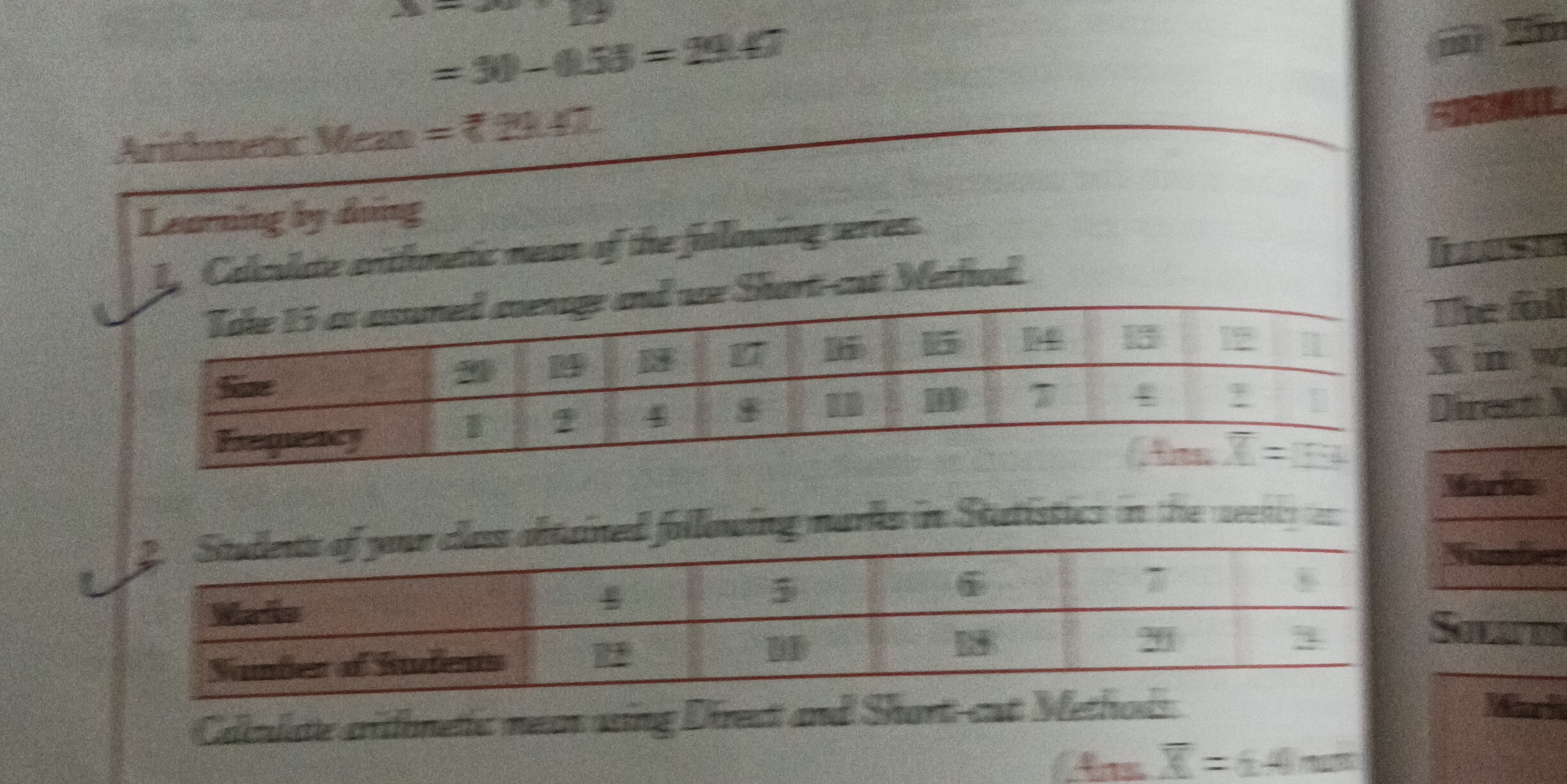1. Calculate arithmetic mean of the following series. Take 15 as assumed average and use Short-cut Method. Size: 20, 19, 18, 17, 16, 15, 14, 13, 12, 11 Frequency: 1, 2, 4, 8, 10,... 1. Calculate arithmetic mean of the following series. Take 15 as assumed average and use Short-cut Method. Size: 20, 19, 18, 17, 16, 15, 14, 13, 12, 11 Frequency: 1, 2, 4, 8, 10, 10, 7, 4, 2, 1 2. Students of your class obtained following marks in Statistics Obtain the weekly test. Marks: 4, 5, 6, 7, 8 Number of Students: 12, 10, 18, 20, 20 Calculate arithmetic mean using Direct and Short-cut Methods.

Understand the Problem
The image contains two math problems related to calculating the arithmetic mean (average) of data sets.
Problem 1: asks to calculate the arithmetic mean of a series of numbers (sizes) using the short-cut method and assuming 15 as the assumed average.
Problem 2: involves calculating the arithmetic mean of marks obtained by students in statistics using both the direct and short-cut methods.
Answer
1. $\approx 15.53$ 2. $6.325$ (Direct and Short-cut)
Answer for screen readers
- Arithmetic Mean (Short-cut Method): $\approx 15.53$
- Arithmetic Mean (Direct Method): $6.325$ Arithmetic Mean (Short-cut Method): $6.325$
Steps to Solve
- Calculate the deviations ($d_i$) from the assumed mean for Problem 1
The assumed mean ($A$) is 15. The deviation $d_i$ for each size ($x_i$) is given by $d_i = x_i - A$.
$d_1 = 20 - 15 = 5$ $d_2 = 19 - 15 = 4$ $d_3 = 18 - 15 = 3$ $d_4 = 17 - 15 = 2$ $d_5 = 16 - 15 = 1$ $d_6 = 15 - 15 = 0$ $d_7 = 14 - 15 = -1$ $d_8 = 13 - 15 = -2$ $d_9 = 12 - 15 = -3$ $d_{10} = 11 - 15 = -4$
- Calculate $f_i \cdot d_i$ for Problem 1
Multiply each deviation $d_i$ by its corresponding frequency $f_i$.
$f_1d_1 = 1 \cdot 5 = 5$ $f_2d_2 = 2 \cdot 4 = 8$ $f_3d_3 = 4 \cdot 3 = 12$ $f_4d_4 = 8 \cdot 2 = 16$ $f_5d_5 = 10 \cdot 1 = 10$ $f_6d_6 = 10 \cdot 0 = 0$ $f_7d_7 = 7 \cdot (-1) = -7$ $f_8d_8 = 4 \cdot (-2) = -8$ $f_9d_9 = 2 \cdot (-3) = -6$ $f_{10}d_{10} = 1 \cdot (-4) = -4$
- Calculate $\sum f_i \cdot d_i$ and $\sum f_i$ for Problem 1
Sum the $f_i \cdot d_i$ values and the frequencies.
$\sum f_i d_i = 5 + 8 + 12 + 16 + 10 + 0 - 7 - 8 - 6 - 4 = 26$ $\sum f_i = 1 + 2 + 4 + 8 + 10 + 10 + 7 + 4 + 2 + 1 = 49$
- Calculate the arithmetic mean using the short-cut method for Problem 1
The formula for the arithmetic mean using the short-cut method is: $\bar{x} = A + \frac{\sum f_i d_i}{\sum f_i}$
$\bar{x} = 15 + \frac{26}{49} = 15 + 0.5306 \approx 15.53$
- Calculate the arithmetic mean using the direct method for Problem 2
The formula for the arithmetic mean using the direct method is: $\bar{x} = \frac{\sum f_i x_i}{\sum f_i}$
$f_1x_1 = 12 \cdot 4 = 48$ $f_2x_2 = 10 \cdot 5 = 50$ $f_3x_3 = 18 \cdot 6 = 108$ $f_4x_4 = 20 \cdot 7 = 140$ $f_5x_5 = 20 \cdot 8 = 160$
$\sum f_i x_i = 48 + 50 + 108 + 140 + 160 = 506$ $\sum f_i = 12 + 10 + 18 + 20 + 20 = 80$
$\bar{x} = \frac{506}{80} = 6.325$
- Calculate the arithmetic mean using the short-cut method for Problem 2
Let's take the assumed mean ($A$) to be 6. $d_i = x_i - A$
$d_1 = 4 - 6 = -2$ $d_2 = 5 - 6 = -1$ $d_3 = 6 - 6 = 0$ $d_4 = 7 - 6 = 1$ $d_5 = 8 - 6 = 2$
$f_1d_1 = 12 \cdot (-2) = -24$ $f_2d_2 = 10 \cdot (-1) = -10$ $f_3d_3 = 18 \cdot 0 = 0$ $f_4d_4 = 20 \cdot 1 = 20$ $f_5d_5 = 20 \cdot 2 = 40$
$\sum f_i d_i = -24 - 10 + 0 + 20 + 40 = 26$ $\sum f_i = 80$
$\bar{x} = A + \frac{\sum f_i d_i}{\sum f_i}$ $\bar{x} = 6 + \frac{26}{80} = 6 + 0.325 = 6.325$
- Arithmetic Mean (Short-cut Method): $\approx 15.53$
- Arithmetic Mean (Direct Method): $6.325$ Arithmetic Mean (Short-cut Method): $6.325$
More Information
The short-cut method is useful when dealing with large numbers, as it simplifies calculations by using deviations from an assumed mean. Both the direct and short-cut methods should yield the same result when calculated correctly, offering a way to verify the calculations.
Tips
A common mistake is making errors in calculating the deviations $d_i$ or when multiplying $f_i$ with $d_i$ and summing them up. Another mistake is choosing the wrong formula or incorrectly applying the formula. Always double-check the calculations and ensure the correct formula is used.
AI-generated content may contain errors. Please verify critical information